
Box-elder syrup comparison

I was stunned by the productivity of the one box-elder tree we tapped --- after a single bright, sunny day, our two-gallon bucket was nearly completely full!
I usually cook down my
sap in stages, letting a pan of the liquid sit on the wood stove until
it's partway cooked down, then later combining that sap with other
partway-cooked-down  sap
to cook up a larger batch of syrup. But I wanted to know right off the
bat whether box-elder syrup was worth making, so I took our bucket full
of sap and cooked it all the way down over the course of 24 hours. The
result was a quarter of a cup of syrup that lacked the bright gold color
of maple syrup and the delicate vanilla-like scent, but tasted every
bit as good. (Mark said the box-elder sap might be slightly less sweet
per unit volume, but he still licked his lips after the taste test!)
sap
to cook up a larger batch of syrup. But I wanted to know right off the
bat whether box-elder syrup was worth making, so I took our bucket full
of sap and cooked it all the way down over the course of 24 hours. The
result was a quarter of a cup of syrup that lacked the bright gold color
of maple syrup and the delicate vanilla-like scent, but tasted every
bit as good. (Mark said the box-elder sap might be slightly less sweet
per unit volume, but he still licked his lips after the taste test!)
I realized in the process
that I'd never actually gotten a comparable figure for how much syrup
we get out of sugar-maple sap, so I took the half gallon of sap that
came from our sugar maple during the same time period and cooked it
down, resulting in an eighth of a cup of syrup.
For those keeping track
at home, that means my box-elder sap-to-syrup ratio is 115:1, while the
sugar-maple sap-to-syrup ratio is 64:1. On the other hand, we got nearly
four times as much sap from the box-elder during the same time period,
so actual yields of syrup from the two trees were twice as high for the
box-elder!

The good news is that we
have hundreds of box-elders within easy tapping distance. The bad news
is that, if we go beyond tapping a tree or two at a time, we actually
have to put effort into the operation. Mark asked me to estimate how
many human-hours it took to create half a cup of maple syrup (what we'd
produced in January) and I figured about an hour, if that. The reason
the project has been so un-time-consuming in the past is that the sap
bucket is right on my daily walk, so it only takes a couple of minutes
to swap out containers each day. After that, the sap just sits on top of
the wood stove, which we're running anyway to heat the trailer, so
energy use is also kept at a minimum. For larger amounts of sap, we'd
have to make special sap-carrying trips and figure out some way to cook
down the sap efficiently (probably outside).
We'll have to put some thought into the right size for our own syruping
operation --- the sweet spot, if you will. In the meantime, I'm
experimenting with maple-syrup recipes for the next volume in the Farmstead Feast series and am taking suggestions. Other than poured over pancakes, what's your favorite way to eat maple syrup?
Want more in-depth information? Browse through our books.
Or explore more posts by date or by subject.
About us: Anna Hess and Mark Hamilton spent over a decade living self-sufficiently in the mountains of Virginia before moving north to start over from scratch in the foothills of Ohio. They've experimented with permaculture, no-till gardening, trailersteading, home-based microbusinesses and much more, writing about their adventures in both blogs and books.
Want to be notified when new comments are posted on this page? Click on the RSS button after you add a comment to subscribe to the comment feed, or simply check the box beside "email replies to me" while writing your comment.

I have two teaspoons of Canadian maple syrup in my coffee every single morning.
My family has been making maple syrup for home use since the early 1820s. My Grandpa was the last generation, in my particular line, to make maple syrup for the home table. I have a photo of him in the late 70s, making maple syrup. He used a huge black cast iron cauldron, hung from a log frame he constructed every year, over an open fire. It was an annual ritual, and required a lot of focus and time. BUT it was a very social time. People from the area dropped in to chat with Grandpa constantly, sitting in front of the open fire with him as he skimmed and boiled. He made the best maple syrup I tasted in my life, there is nothing else like it today. The wood smoke and ash added a wonderful element to the taste. It was made with love, and the taste reflected it.
We add a little bit to tomato paste to make pizza sauce. The sweetness cuts the acidity a smidge and the syrup also makes the paste a little more fluid and spreadable.
A little bit also goes to granola.
But pancakes, waffles, and french toast are the primary syrup accoutrements.
Maggie --- Food tastes even better when it has memories behind it!
Karen --- I have a feeling that once we have homegrown milk, we'll come up with a similar combo that tastes great!
Jackie --- That sounds delicious!
Jake --- I use honey like that in pizza sauce, especially if the tomatoes are late-season and not as sweet. Definitely provides a flavor boost, although I've always felt a tiny bit like I'm cheating.
Rae --- I believe you can tap any kind of maple, although the only ones I've researched are box-elders, sugar maples, and silver maples. The sugar maples have the most sugar, so you'll need to boil the others down a bit more.
As for walnut --- I'd thought that was on the don't tap list. (Although, like you, I've heard that black birch is good to tap.) What I'd do if I were experimenting is to boil down one batch of each species to make sure you like it, then mix together any with similar flavors in the future. We mix our box-elder and sugar maple sap together now that I've determined they're compatible, but I probably wouldn't mix in birch sap since it will have a minty flavor.